D.W. asks about summer gardening in Florida:
“Hi David,
A couple of years ago I acquired property (10+ acres) with the intent to homestead (self-sufficiency a primary intent) and after getting it cleaned up am ready to invest in food production.
I know you’re probably thinking why it took me this long….
The property was an abandoned nursery (20+ years) and therefore had lots of lovely landscape cloth, buried irrigation piping, hundreds of sprinkler heads, grow-houses and lots of other goodies all buried underneath wonderfully thick vines. At this point I am very close to completion of the clearing phase and set aside 1.25 acre niche for home, equipment and food production/garden areas. Within this I would like to allocate about 1/3 acre for a food forest.
My research has led me to your site and recently heard your composting presentation on the home-grow network (think that’s the correct name). That led to the purchase of several of your books and doing a lot more research into Permaculture. I would first like to thank you so much for writing about Florida-specific growing methods and plants for the central Florida area. It appears to me that this environment (I am located [near Orlando]) has unique challenges not encountered in many other places. Also your books avoid being overly technical so that the beginner is not overwhelmed and encouraged to just get started. Much appreciated!! :-).
Now that you have me equipped with rudimentary knowledge of the system, etc. as well as enthusiasm to begin… It is mid-July in Florida and I have an open pasture as my palate. I’m accumulating compost materials as rapidly as possible, however the brutal heat and humidity seem to make it a good time NOT to plant. Are there plants I can be getting in the ground now? If not when? if your recommendation is to wait what do you suggest I do in the meantime? I have the ability to irrigate but obviously there is no shading canopy available yet. May have missed in your books but saw no reference to timing other than to get started NOW.
Thanks again for the information easily digested, your renegade approach, parodies and humor in your articles and videos. They are a hoot! The one about coffee connoisseur and Yam workouts especially got me laughing heartily Keep em coming – you have a gift.
Please advise,
Thank you,
D.W.”
Thank you for the kind words, D. W.
As you have experienced, summer in Florida is no joke. It’s hot, humid, and miserable on plants. You’re right to not “jump right in,” even though I’m sure it’s tempting.
Here are my recommendations for summer gardening in Florida.
Vegetables that Take the Heat
There are a few options open to you right now on the annuals front: yard-long beans, okra and southern peas. That’s about it. Most everything else will simply die.

Snake beans can take the heat!
Even these will suffer a bit in the heat, but not like everything else does.
If you plant yard-long beans now, you should be picking beans by September. Same with okra and southern peas. I use southern peas as a green manure in the hot months, planting them where I plan to plant fall gardens later. Just buy a bag of black-eyed peas from the grocery store, soak them overnight, then toss and rake them into a bed. Keep watered and they’ll be up in a few days.
For perennials, you can still plant moringa, chaya and cassava in the summer.
Or you can just skip planting crops altogether and spend your time getting ready for a killer fall garden.
Use the Summer as a Head-start on Fall Gardening
Taking the time to make compost in summer is a good start. Make piles and get them going so you have compost to feed your gardens in fall. Water the piles well to get them going, unless you’re getting plenty of rain.
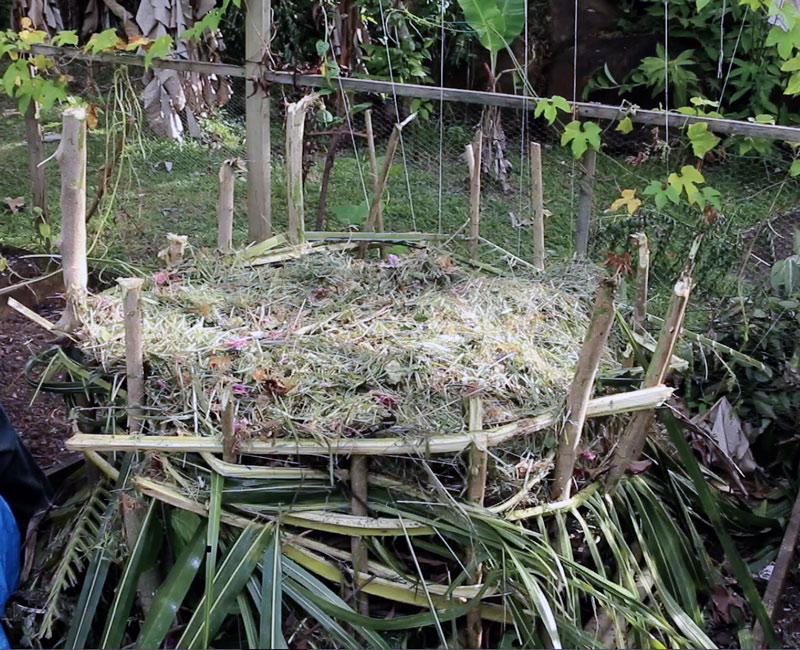
Another great task for summer: use the sun to your advantage!
Put down black plastic sheeting or woven plastic landscape fabric over areas you would like to garden in the fall and let the sun ROAST the weeds!
That’s one thing the heat of summer is great for: toasting weeds.
Alternately, you can start digging beds, making lasagna gardens and deciding where you’ll be growing in fall.
These were what the beds in my Florida kitchen garden looked like:
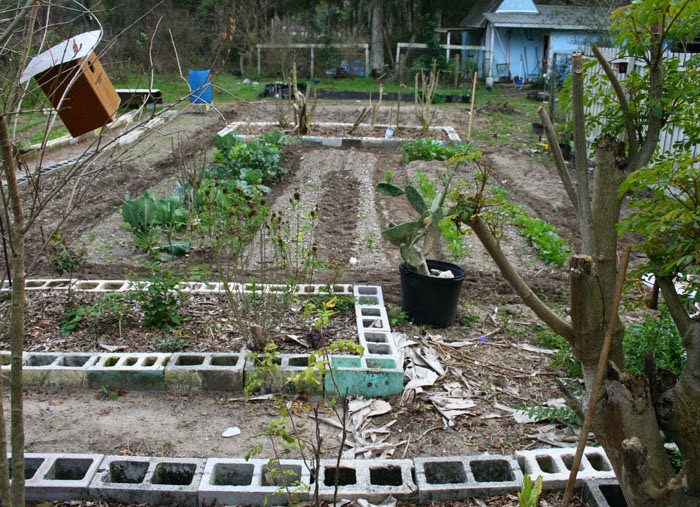
Get Going on Fall
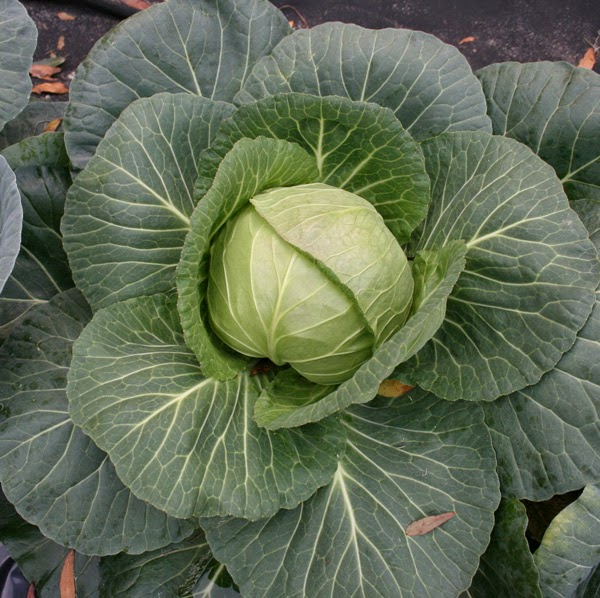
I usually got serious about fall gardening in late September and early October.
The first plants I’d put in were another round of warm-season crops like hot peppers, eggplants and beans.
In October I’d plant broccoli, cauliflower, turnips, lettuce, cabbages, carrots, kale, and other plants that can take a little cold.
Another thing I always spent time doing during fall was digging new garden beds.
When the weather cools off, it’s actually nice to be outside again. Use it to your advantage.
Finally – fall is the time to plant fruit and nut trees and shrubs. I always put in a new round of them in the fall.
For vegetable planting times in North, Central and South Florida, check out the chart UF posted here.
It’s very useful.
Totally Crazy Easy Florida Gardening: The Secret to Growing Piles of Food in the Sunshine State
Related to today’s post, Lina wrote this week:
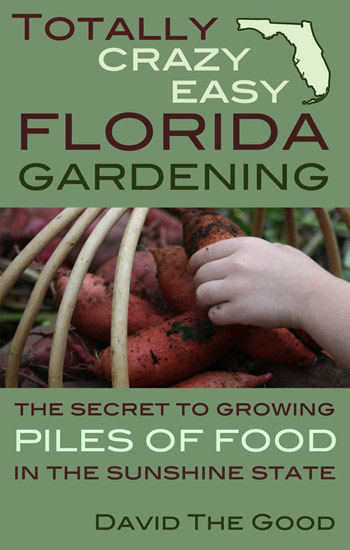 “David, got my books! Two down and one to go….. one suggestion on your Totally Crazy Easy Florida Gardening book made me become hopefull again: checking out the UF Extension gardening guide for Florida (for me South Florida). All my spring plantings of annuals were off. No wonder little thrived…. I followed the planting times for colder zones. All the advice about growing seeds indoors is irrelevant for South Fl. I am learning so much. Thank you soooo much for all your help.
“David, got my books! Two down and one to go….. one suggestion on your Totally Crazy Easy Florida Gardening book made me become hopefull again: checking out the UF Extension gardening guide for Florida (for me South Florida). All my spring plantings of annuals were off. No wonder little thrived…. I followed the planting times for colder zones. All the advice about growing seeds indoors is irrelevant for South Fl. I am learning so much. Thank you soooo much for all your help.
Check out Totally Crazy Easy Florida Gardening if you don’t have it – it’s based on years of experience with Florida gardening.
It’s also now available in audiobook format, read by yours truly. It’s not a long book but it has the keys you need to literally grow piles of food.
Conclusion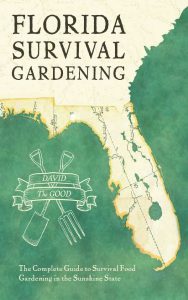
Summer may not be the best time to garden in Florida, but it’s not completely worthless. Throw down some weed-killing cover, plant a few yard-long beans and get planning for fall.
Just be sure to avoid going outdoors between 9AM and 4:30PM or you may be incinerated by the sun.

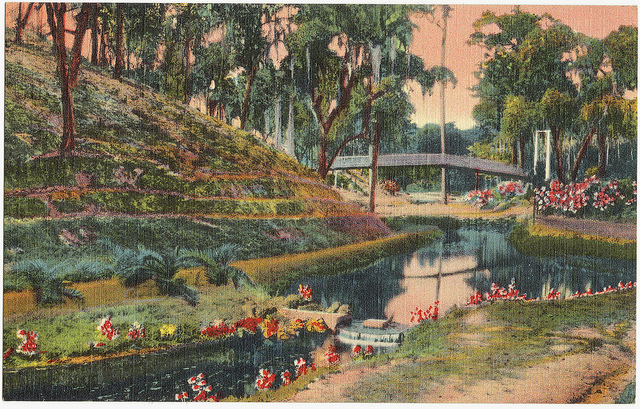
16 comments
I have done well planting on the east side of trees and my house. Anything that will cast shade, and protect plants from wilting. I know 2 things from DW’s letter, there are no trees, and the location is rough. Orlando’s heat is rough on summer, I live in a much more forgiving pay of Florida, but the sun’s intensity is still a foe that can be difficult to contend with. Even my watermelons, that have no shade protection, are struggling. My advice, and I am no expert, is to take advantage of the morning sun, and protect your crops from the midday and afternoon sun.
There are other things that will grow in Florida’s summer heat: watermelons, cantalopes, sweet potatoes, amaranth* (tampala), purslane*, culantro, peanuts. * indicates the plants grow wild in florida. there are tropical “spinach” plants (not related to temperate spinach) that may be OK in the Florida summer.
Yes – Gynura procumbens, AKA “longevity spinach” takes the heat. As for watermelons and canteloupes, I would think it’s too late to plant them now.
Thank you David that’s exactly what i needed to know. Danny you aren’t kidding … It’s 94 right now with heat index of 115. Will most likely forgo any summer planting and continue to prep for Fall
Cool man, just keep at it. Learn as you go.
No doubt it is rough here in summer. I’m just thankful we are having a bit of rainy season this year. Cow peas are rocking and the peppers are loving the heat. And I “pushed the zone” and put some things in part shade/micro climates and most are working. Still getting cherry tomatoes and actually got cucumbers for the first time. Planted seeds in two big flower pots in April (yep late for 9b) on my north facing front porch and have been finding cukes hiding in the flowers. Yay! Lettuce called it quits, but there’s always Okinawa spinach, Ethiopian kale, callaloo and Egyptian spinach for heat loving greens. It is miserable if you aren’t done in the garden by 8 am! Still waiting for the Ivy Gourds to set flowers, but not sure when that’s supposed to happen.
You’ve got some good heat-lovers there. Nice work, Kristi.
I think those ivy gourds will jump soon.
As a college student this is the first year I’ve had a yard and I learned the hard way the Florida sun isn’t friendly. I thought I could grow any squash and cucumbers I found at homedepot because they like the heat. Well my butternut squash is all but dead and my cucumbers got destroyed by pickleworms. I thought I was doing something wrong. Good to know everyone has the same problem as me lol. At least I know and only a few months till prime growing season. I thought for the longest time summer was the prime growing season.
Yeah, gotta plant them early or late! Seminole pumpkins take the heat better than butternut, in my experience, but I still wouldn’t plant them at this time of year.
You can also grow roselle, false roselle, and pigeon pea which love the summer heat and rain and C. moschata varieties of pumpkin/squash. The Jamaican variety I have right now is trying to take over as much of the yard as possible averaging around 14lbs each. For me it grows much better than seminole pumpkin. But in its defense I am growing them on piles of aged wood chips. I actually have a couple of plants that survived from last year and are regrowing this year. Not sure if that is a bad thing or good. Will have to see how well it produces. Yams, gingers, and turmeric also spring up and grow this time of year. But it will be better to plant them earlier in the Spring. For me Summer is my favorite time of year to grow in Florida. No need to water at all with the rain. But my garden/micro food forest is mainly perennial. Less work overall.
DW. if you have mainly pasture with no trees look for sources of mulch makes a huge difference. Also let some areas grow wild for a few years to create micro canopies and nature habitats. You can select cut and plant within that area. Plus you might get some nice surprises when you let nature do its thing. Best of luck.
If you’re in South Florida I would plant roselle and pigeon peas now and feel alright about it, but farther north in the state you may not get great yields. Pigeon peas might not be big enough before the cold.
And you’re right – the perennials keep kicking!
My best crops at the moment are Luffa sponges, FL Grove peppers, ginger, horseradish and tumeric. I just planted two types of bush beans (yellow wax and royal burgundy), a slew of Chinese noodle beans and am doing a lot of propagation work in the shade with mulberry, papaya, coffee arabica, etc. Can’t wait til fall!
You’ve been busy!
I never tried horseradish in Florida. Is this your first year growing it?
These plants are in their second year. First year they got kind of neglected, but this year they’re looking good in half barrels with good soil and regular watering. I’ll probably dig one up at the end of the season to see where they’re at & may let the others go to a third year depending on root size.
I have a question about nitrogen fixing plants. I have heard that some people innoculate their beans. I always thought here in S. Florida we already have the bacteria in our soil so no need to innoculate. Well, I just pulled up my black eyed peas – they were looking a little sooty with all the rain (and aphids). They didn’t really produce much this year – a disappointment for sure, but only one of the plants I pulled up had 3 or 4 little nitrogen balls on the fine hairy roots. The other plants had none, but also didn’t really bring up a ton of fine roots so now I don’t know if there was nitrogen down there or not. Is it to some advantage to innoculate – as an insurance? Is there a certain time I should have harvested the plants to insure the nitrogen is fixed? The plants were looking ratty so I figured I would solarize for a month or two instead. Do nitrogen-fixing /plants only fix nitrogen when you cut them down? Just wondering…
i buy 50 lb bags of sunflower seeds and bombard my garden with them
sunflowers turn a barren summer wasteland into a beautiful area loved by all!!
Comments are closed.